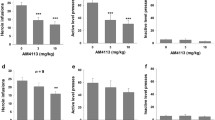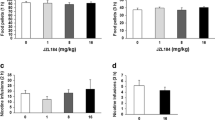Abstract
Rationale
The endocannabinoid system is composed of endocannabinoids (such as anandamide), their target receptors (CB1 and CB2 receptors, CB1Rs and CB2Rs), the enzymes that degrade them (fatty-acid-amide-hydrolase (FAAH) for anandamide), and an endocannabinoid transporter. FAAH inhibition has been recently identified as having a critical involvement in behaviors related to nicotine addiction and has been shown to reduce the effect of nicotine on the mesolimbic dopaminergic system via CB1R and peroxisome proliferator-activated receptor alpha (PPARα). Thus, inhibition of FAAH may represent a novel strategy for smoking cessation, but its mechanism of action on relapse to nicotine seeking is still unknown.
Objective
The study aims to explore the mechanism of action of the inhibitor of FAAH activity, URB597, on relapse to nicotine seeking by evaluating the effect of the CB1R, CB2R, and PPARα antagonists on the attenuating effect of URB597 on cue-induced reinstatement of nicotine seeking in rats.
Results
URB597 reduced cue-induced reinstatement of nicotine seeking, an effect that was reversed by the CB1R antagonist rimonabant, but not by the CB2R or PPARα antagonists AM630 and MK886, respectively.
Conclusions
These results indicate that URB597 reduces cue-induced reinstatement in rats through a CB1 receptor-dependent mechanism, and not via CB2R or PPARα. Since FAAH inhibition represent a novel and promising strategy for tobacco smoking cessation, dissecting how it produces its action may lead to a better understanding of the neurobiological mechanisms underlying nicotine addiction.

Similar content being viewed by others
References
Boyd ST, Fremming BA (2005) Rimonabant—a selective CB1 antagonist. Ann Pharmacother 39:684–90
Conklin CA (2006) Environments as cues to smoke: implications for human extinction-based research and treatment. Exp Clin Psychopharmacol 14:12–9
Crombag HS, Bossert JM, Koya E, Shaham Y (2008) Review. Context-induced relapse to drug seeking: a review. Philos Trans R Soc Lond Ser B Biol Sci 363:3233–43
Di Marzo V, Bifulco M, De Petrocellis L (2004) The endocannabinoid system and its therapeutic exploitation. Nat Rev Drug Discov 3:771–84
Diergaarde L, de Vries W, Raaso H, Schoffelmeer AN, De Vries TJ (2008) Contextual renewal of nicotine seeking in rats and its suppression by the cannabinoid-1 receptor antagonist Rimonabant (SR141716A). Neuropharmacology 55:712–6
Dols M, van den Hout M, Kindt M, Willems B (2002) The urge to smoke depends on the expectation of smoking. Addiction 97:87–93
Epstein DH, Preston KL, Stewart J, Shaham Y (2006) Toward a model of drug relapse: an assessment of the validity of the reinstatement procedure. Psychopharmacology 189:1–16
Forget B, Coen KM, Le Foll B (2009) Inhibition of fatty acid amide hydrolase reduces reinstatement of nicotine seeking but not break point for nicotine self-administration--comparison with CB(1) receptor blockade. Psychopharmacology 205:613–24
Forget B, Pushparaj A, Le Foll B (2010a) Granular insular cortex inactivation as a novel therapeutic strategy for nicotine addiction. Biol Psychiatry 68:265–71
Forget B, Wertheim C, Mascia P, Pushparaj A, Goldberg SR, Le Foll B (2010b) Noradrenergic alpha1 receptors as a novel target for the treatment of nicotine addiction. Neuropsychopharmacology 35:1751–60
Gamaleddin I, Wertheim C, Zhu AZ, Coen KM, Vemuri K, Makryannis A, Goldberg SR, Le Foll B (2012a) Cannabinoid receptor stimulation increases motivation for nicotine and nicotine seeking. Addict Biol 17:47–61
Gamaleddin I, Zvonok A, Makriyannis A, Goldberg SR, Le Foll B (2012b) Effects of a selective cannabinoid CB2 agonist and antagonist on intravenous nicotine self administration and reinstatement of nicotine seeking. PLoS ONE 7:e29900
Howlett AC, Barth F, Bonner TI, Cabral G, Casellas P, Devane WA, Felder CC, Herkenham M, Mackie K, Martin BR, Mechoulam R, Pertwee RG (2002) International Union of Pharmacology. XXVII. Classification of cannabinoid receptors. Pharmacol Rev 54:161–202
Justinova Z, Mangieri RA, Bortolato M, Chefer SI, Mukhin AG, Clapper JR, King AR, Redhi GH, Yasar S, Piomelli D, Goldberg SR (2008) Fatty acid amide hydrolase inhibition heightens anandamide signaling without producing reinforcing effects in primates. Biol Psychiatry 64:930–7
Justinova Z, Panlilio LV, Moreno-Sanz G, Redhi GH, Auber A, Secci ME, Mascia P, Bandiera T, Armirotti A, Bertorelli R, Chefer SI, Barnes C, Yasar S, Piomelli D, Goldberg SR (2015) Effects of fatty acid amide hydrolase (FAAH) inhibitors in non-human primate models of nicotine reward and relapse. Neuropsychopharmacology 40:2185–97
Kathuria S, Gaetani S, Fegley D, Valino F, Duranti A, Tontini A, Mor M, Tarzia G, La Rana G, Calignano A, Giustino A, Tattoli M, Palmery M, Cuomo V, Piomelli D (2003) Modulation of anxiety through blockade of anandamide hydrolysis. Nat Med 9:76–81
Kehrer JP, Biswal SS, La E, Thuillier P, Datta K, Fischer SM, Vanden Heuvel JP (2001) Inhibition of peroxisome-proliferator-activated receptor (PPAR)alpha by MK886. Biochem J 356:899–906
Khanna IK, Alexander CW (2011) Fatty acid amide hydrolase inhibitors—progress and potential. CNS Neurol Dis Drug Targets 10:545–58
Le Foll B, Forget B, Aubin HJ, Goldberg SR (2008) Blocking cannabinoid CB1 receptors for the treatment of nicotine dependence: insights from pre-clinical and clinical studies. Addict Biol 13:239–52
Le Foll B, Goldberg SR (2006) Nicotine as a typical drug of abuse in experimental animals and humans. Psychopharmacology 184:367–81
Lopez Rodriguez AB, Mateos Vicente B, Romero-Zerbo SY, Rodriguez-Rodriguez N, Bellini MJ, Rodriguez de Fonseca F, Bermudez-Silva FJ, Azcoitia I, Garcia-Segura LM, Viveros MP (2011) Estradiol decreases cortical reactive astrogliosis after brain injury by a mechanism involving cannabinoid receptors. Cereb Cortex 21:2046–55
Luchicchi A, Lecca S, Carta S, Pillolla G, Muntoni AL, Yasar S, Goldberg SR, Pistis M (2010) Effects of fatty acid amide hydrolase inhibition on neuronal responses to nicotine, cocaine and morphine in the nucleus accumbens shell and ventral tegmental area: involvement of PPAR-alpha nuclear receptors. Addict Biol 15:277–88
Mazzola C, Medalie J, Scherma M, Panlilio LV, Solinas M, Tanda G, Drago F, Cadet JL, Goldberg SR, Yasar S (2009) Fatty acid amide hydrolase (FAAH) inhibition enhances memory acquisition through activation of PPAR-alpha nuclear receptors. Learn Mem 16:332–7
Melis M, Pillolla G, Luchicchi A, Muntoni AL, Yasar S, Goldberg SR, Pistis M (2008) Endogenous fatty acid ethanolamides suppress nicotine-induced activation of mesolimbic dopamine neurons through nuclear receptors. J Neurosci 28:13985–94
Mukherjee S, Adams M, Whiteaker K, Daza A, Kage K, Cassar S, Meyer M, Yao BB (2004) Species comparison and pharmacological characterization of rat and human CB2 cannabinoid receptors. Eur J Pharmacol 505:1–9
Niaura R, Shadel WG, Abrams DB, Monti PM, Rohsenow DJ, Sirota A (1998) Individual differences in cue reactivity among smokers trying to quit: effects of gender and cue type. Addict Behav 23:209–24
O'Brien CP (2005) Anticraving medications for relapse prevention: a possible new class of psychoactive medications. Am J Psychiatry 162:1423–31
Panlilio LV, Justinova Z, Goldberg SR (2013) Inhibition of FAAH and activation of PPAR: new approaches to the treatment of cognitive dysfunction and drug addiction. Pharmacol Ther 138:84–102
Piomelli D, Tarzia G, Duranti A, Tontini A, Mor M, Compton TR, Dasse O, Monaghan EP, Parrott JA, Putman D (2006) Pharmacological profile of the selective FAAH inhibitor KDS-4103 (URB597). CNS Drug Rev 12:21–38
Rodriguez de Fonseca F, Del Arco I, Bermudez-Silva FJ, Bilbao A, Cippitelli A, Navarro M (2005) The endocannabinoid system: physiology and pharmacology. Alcohol Alcohol 40:2–14
Rose JE, Corrigall WA (1997) Nicotine self-administration in animals and humans: similarities and differences. Psychopharmacology 130:28–40
Scherma M, Panlilio LV, Fadda P, Fattore L, Gamaleddin I, Le Foll B, Justinova Z, Mikics E, Haller J, Medalie J, Stroik J, Barnes C, Yasar S, Tanda G, Piomelli D, Fratta W, Goldberg SR (2008) Inhibition of anandamide hydrolysis by cyclohexyl carbamic acid 3'-carbamoyl-3-yl ester (URB597) reverses abuse-related behavioral and neurochemical effects of nicotine in rats. J Pharmacol Exp Ther 327:482–90
Shaham Y, Shalev U, Lu L, De Wit H, Stewart J (2003) The reinstatement model of drug relapse: history, methodology and major findings. Psychopharmacology 168:3–20
Shiffman S, Hickcox M, Paty JA, Gnys M, Kassel JD, Richards TJ (1996) Progression from a smoking lapse to relapse: prediction from abstinence violation effects, nicotine dependence, and lapse characteristics. J Consult Clin Psychol 64:993–1002
Sinha R (2001) How does stress increase risk of drug abuse and relapse? Psychopharmacology 158:343–59
Stoker AK, Markou A (2015) Neurobiological bases of cue- and nicotine-induced reinstatement of nicotine seeking: implications for the development of smoking cessation medications. Curr Top Behav Neurosci 24:125–54
Thewissen R, van den Hout M, Havermans RC, Jansen A (2005) Context-dependency of cue-elicited urge to smoke. Addiction 100:387–96
Waters AJ, Shiffman S, Sayette MA, Paty JA, Gwaltney CJ, Balabanis MH (2004) Cue-provoked craving and nicotine replacement therapy in smoking cessation. J Consult Clin Psychol 72:1136–43
Acknowledgments
We thank A. Pushparaj for his help during the experiments and comments on the manuscript. The experiments comply with the current laws of Canada.
Author information
Authors and Affiliations
Corresponding author
Ethics declarations
Funding
This work was supported by a grant from the Heart and Stroke Foundation no. NA 6901.
Conflict of interest
The authors declare that they have no conflict of interest.
Additional information
In memoriam of Steven R. Goldberg
Rights and permissions
About this article
Cite this article
Forget, B., Guranda, M., Gamaleddin, I. et al. Attenuation of cue-induced reinstatement of nicotine seeking by URB597 through cannabinoid CB1 receptor in rats. Psychopharmacology 233, 1823–1828 (2016). https://doi.org/10.1007/s00213-016-4232-y
Received:
Accepted:
Published:
Issue Date:
DOI: https://doi.org/10.1007/s00213-016-4232-y




